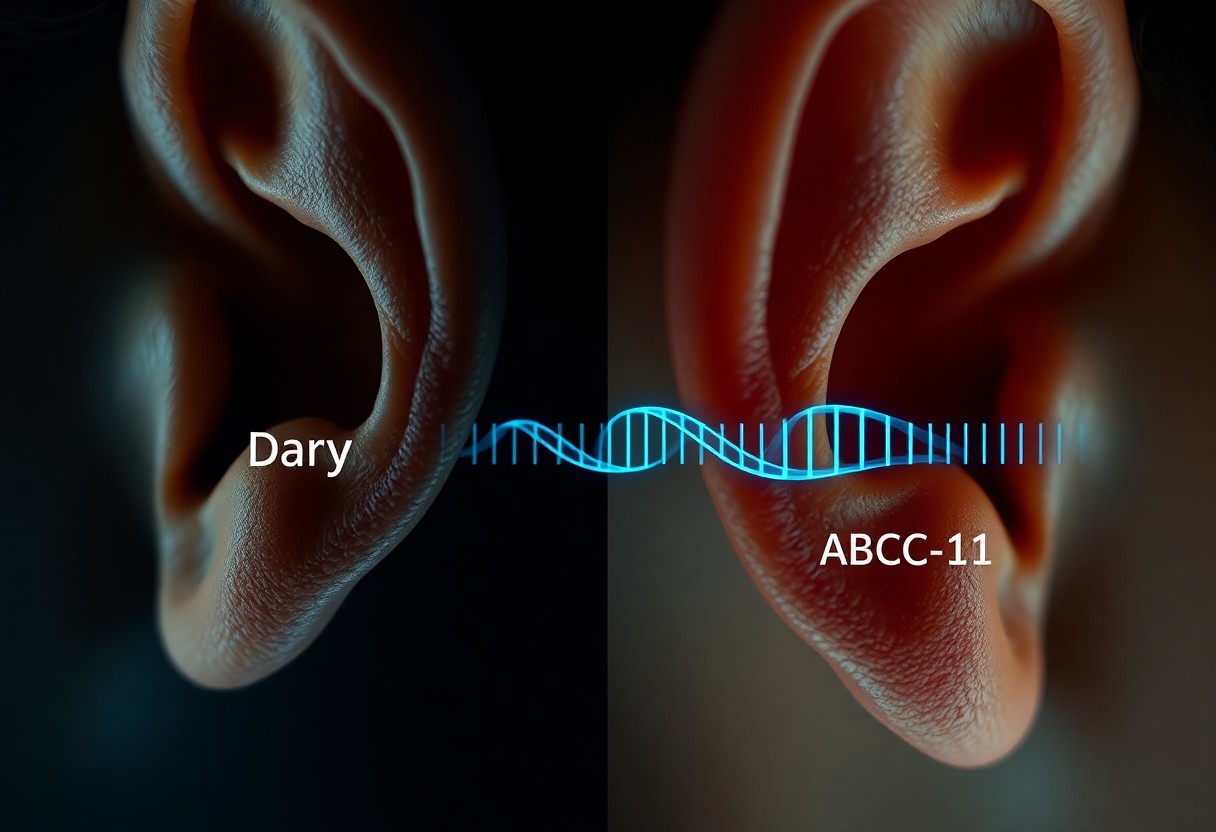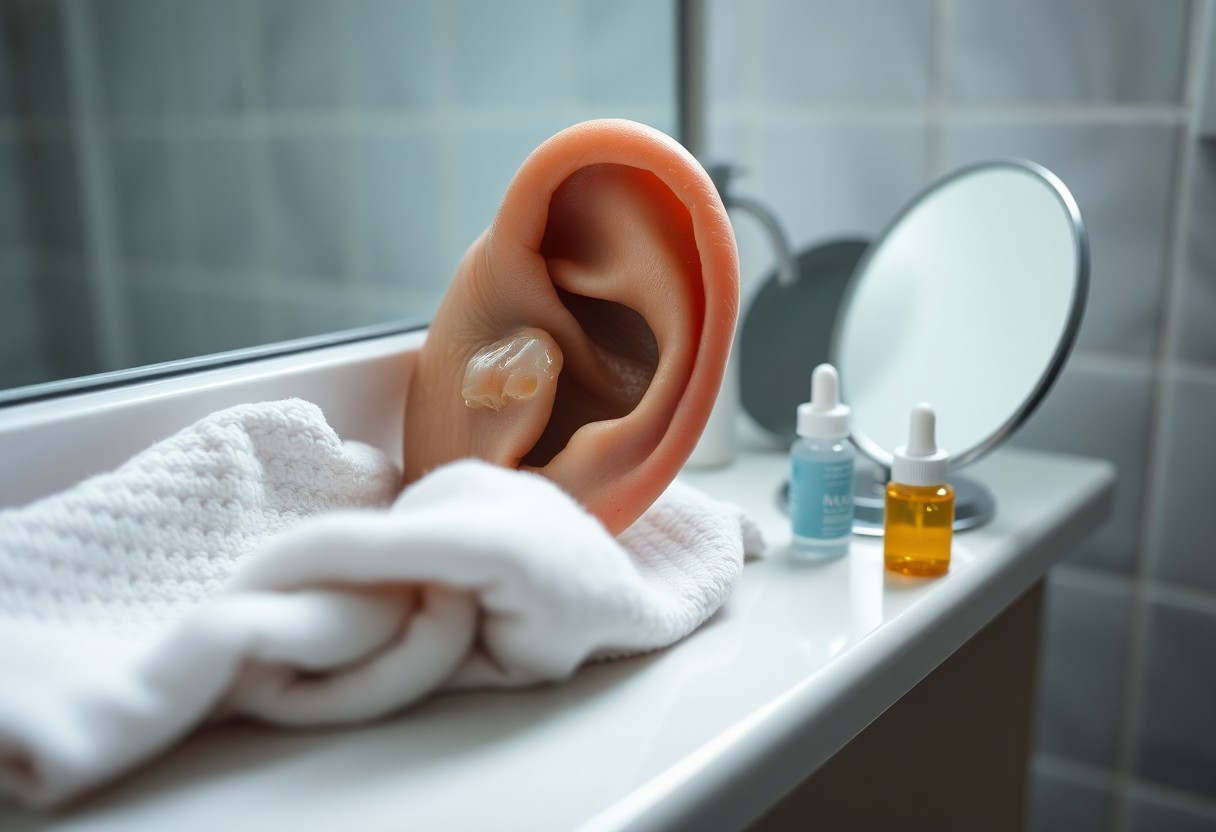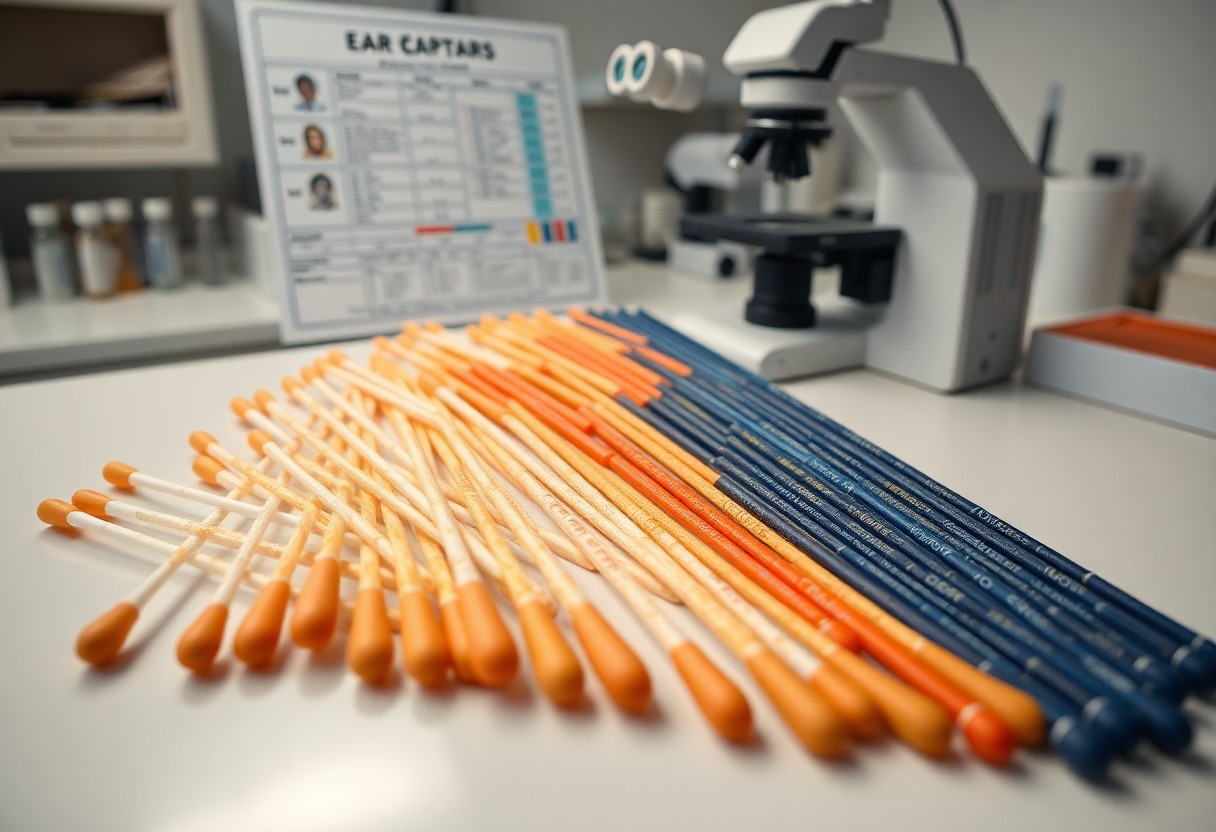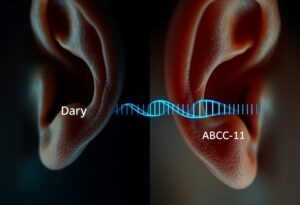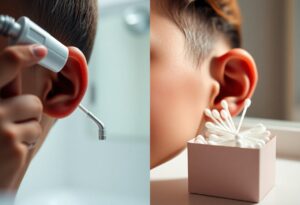There’s a fascinating genetic aspect to the type of earwax you produce—dry or wet. This seemingly minor trait is influenced by your DNA, determining how your body creates earwax and its texture. Understanding the differences between these two types not only sheds light on your genetic heritage but also offers insights into ear health and hygiene practices that may suit you best. Your earwax type can reflect broader biological traits, making it a unique subject worth exploring.
You may be surprised to learn that the type of earwax you possess—whether dry or wet—is primarily determined by genetics. This biological trait can influence not only your ear health but also your susceptibility to certain conditions. Understanding the genetic basis of earwax types can offer insights into your personal health and hygiene practices, as well as interesting evolutionary aspects of human biology. In this post, we will explore the genetics behind your earwax type and what it means for you.
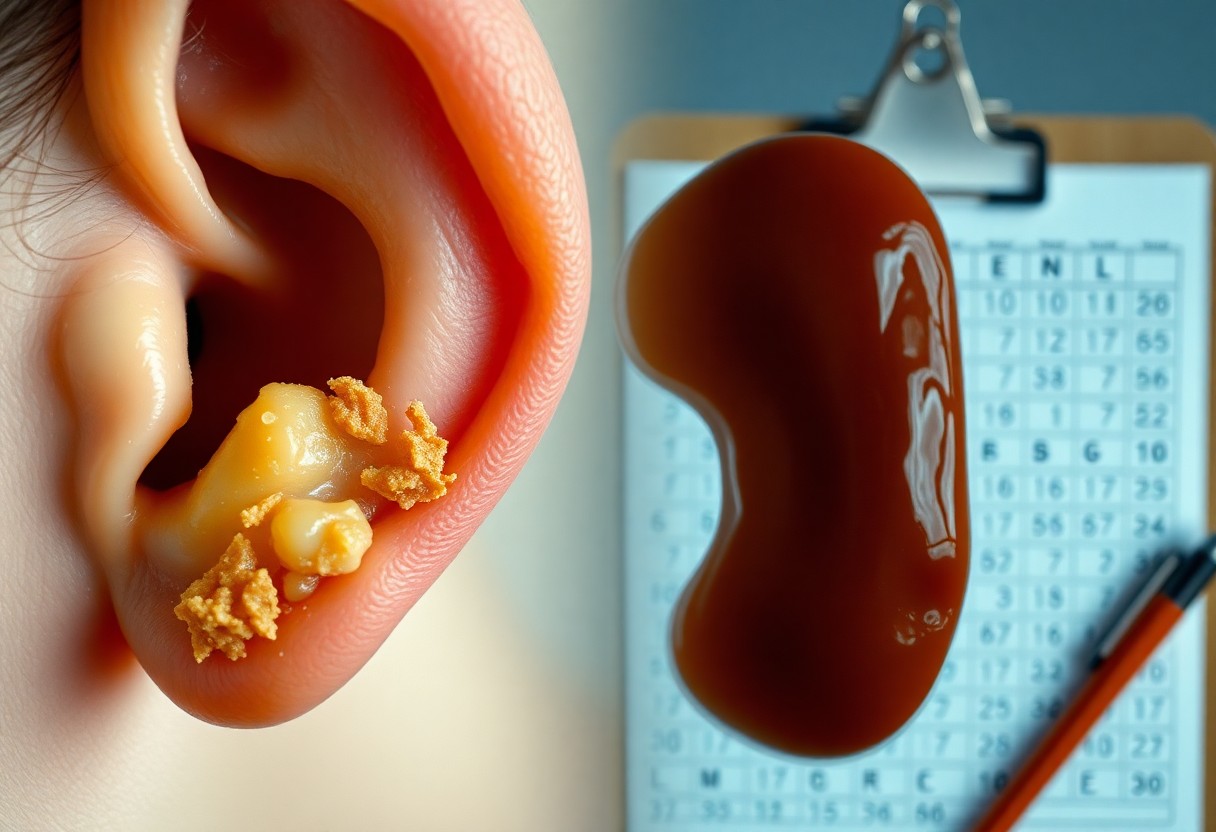
Key Takeaways:
- Dry earwax is a result of a genetic mutation, specifically in the ABCC11 gene, while wet earwax is the ancestral trait.
- The prevalence of dry versus wet earwax varies significantly among different populations; it is more common in East Asian individuals.
- Health implications of earwax types may include differences in susceptibility to certain ear infections and the effectiveness of ear cleaning methods.
Key Takeaways:
- Dry earwax is caused by a mutation in the ABCC11 gene, while wet earwax is the result of the non-mutated form.
- The variation in earwax type is inherited, with dry earwax more common in East Asian populations.
- Earwax type can indicate other genetic traits, such as body odor and sweat gland activity.
The Genetic Blueprint of Earwax Types
Your earwax type is dictated by your genetic makeup, primarily influenced by variations in the ABCC11 gene. Understanding this gene sheds light on why some individuals produce dry earwax while others have a wet version. The following table outlines key aspects of the genetic foundation of earwax types:
| Earwax Type | Genetic Variant |
|---|---|
| Dry Earwax | Mutated ABCC11 Gene |
| Wet Earwax | Non-mutated ABCC11 Gene |
| Dominant Trait | Wet Earwax |
| Recessive Trait | Dry Earwax |
| Frequency in Populations | Varies by ethnicity |
This genetic distinction influences not only personal hygiene preferences but may also reflect ancestral adaptations to different environments.
The Role of the ABCC11 Gene
The ABCC11 gene is responsible for encoding a protein involved in the secretion of earwax. A specific mutation in this gene determines whether you produce dry or wet earwax. This mutation leads to the lack of a protein that modulates the secretion, resulting in the dry form. Your genetic inheritance plays a significant role in determining which variant you possess.
Considering Population Genetics and Variations
Population genetics indicates that the distribution of earwax types changes significantly across different ethnic groups. For instance, up to 80% of East Asians often have dry earwax, whereas a similar percentage of Africans and Europeans usually have wet earwax. These variations are not just biological curiosities; they provide a window into our evolutionary past.
Digging deeper into population genetics highlights fascinating patterns in earwax types across various cultures. For example, the prevalence of dry earwax among East Asians correlates with dietary adaptations and environmental factors, suggesting a link between earwax type and historical migration patterns. Such insights underscore the complex interplay between your genetics and ancestry, illustrating how even a seemingly trivial trait can reveal significant aspects of human evolution and adaptation.
The Genetic Blueprint of Earwax Composition
The Role of the ABCC11 Gene
The ABCC11 gene dictates whether you produce dry or wet earwax, with its specific variant directly linked to your earwax type. Individuals with the ‘G’ allele typically have wet earwax, while those with the ‘A’ allele often produce the dry form. This gene impacts not just earwax composition but also associated bodily functions and traits, emphasizing the interconnected nature of genetics and physical characteristics.
Exploring Allelic Variants and Their Impacts
Variants within the ABCC11 gene significantly influence earwax type, with the ‘A’ allele leading to dry earwax in approximately 2-5% of the global population, predominantly among East Asians. In contrast, the majority of people, particularly those of African and European descent, carry the ‘G’ allele, resulting in wet earwax. These genetic patterns illustrate how evolution and environmental factors have shaped human physiology.
Delving deeper, research shows that the prevalence of dry versus wet earwax can serve as an indicator of your ancestral lineage. For example, populations that migrated from East Asia to other regions exhibit variations in allele frequency, which has been linked to historical climate adaptations. The dry earwax trait likely offered advantages in hot, humid environments by reducing bacterial growth and improving ear hygiene. Therefore, understanding your earwax type not only reveals genetic predispositions but also connects you to a broader story of human evolution and migration.
The Biochemistry of Dry vs. Wet Earwax
The Composition and Characteristics of Dry Earwax
Dry earwax, often light-colored and flaky, contains a higher concentration of keratin proteins compared to its wet counterpart. This type is characterized by its lower lipid content, which contributes to its drier texture. Genetic variations in the ABCC11 gene influence these characteristics, leading to differences in the biochemistry of earwax across populations.
The Composition and Characteristics of Wet Earwax
Wet earwax is typically sticky and moist, rich in lipids and fatty acids. This composition not only gives it a darker color but also enables it to effectively trap dirt and debris, preventing infections. The genetic background you possess, particularly the activity level of the ABCC11 gene, determines the predominance of this type of earwax.
Wet earwax is most commonly associated with individuals of Asian descent, showing about 78% prevalence, whereas in Africans and Europeans, it’s about 90% and 56%, respectively. The lipid-rich composition plays a significant role in maintaining ear health, as its antimicrobial properties aid in preventing infections and managing moisture levels within the ear canal. Understanding these biochemical differences can highlight not only the uniqueness of your earwax but also its evolutionary advantages.
Cultural Perspectives on Earwax Types
| Region | Earwax Type |
| East Asia | Dry |
| Africa | Wet |
| Europe | Wet |
| North America | Variable |
| South America | Variable |
Dry Earwax in East Asian Populations
In East Asian populations, the prevalence of dry earwax is notably high, with studies indicating that around 80% of individuals demonstrate this trait. This characteristic aligns with genetic adaptations that reflect environmental factors. The dry type is often linked to various associated traits, including personal hygiene practices and cultural views toward body care, emphasizing a unique cultural perspective on ear hygiene.
Wet Earwax Predominance in African and European Groups
A significant majority of individuals from African and European populations produce wet earwax, influenced by diverse genetic backgrounds. Approximately 90% of these groups showcase this trait, aligning with historical patterns of migration and population mixing. Cultural norms surrounding ear hygiene differ, often leading to varying practices for ear care and cleanliness.
Additional insights reveal that the wet earwax trait serves practical functions, such as providing moisture and protection against environmental factors, which may explain its predominance in many regions. The cultural attitudes toward earwax in these populations are often shaped by traditional beliefs about cleanliness and health, differentiating practices in ear care across societies. Recognizing these cultural perspectives may enhance your understanding of how genetics and environment intertwine.
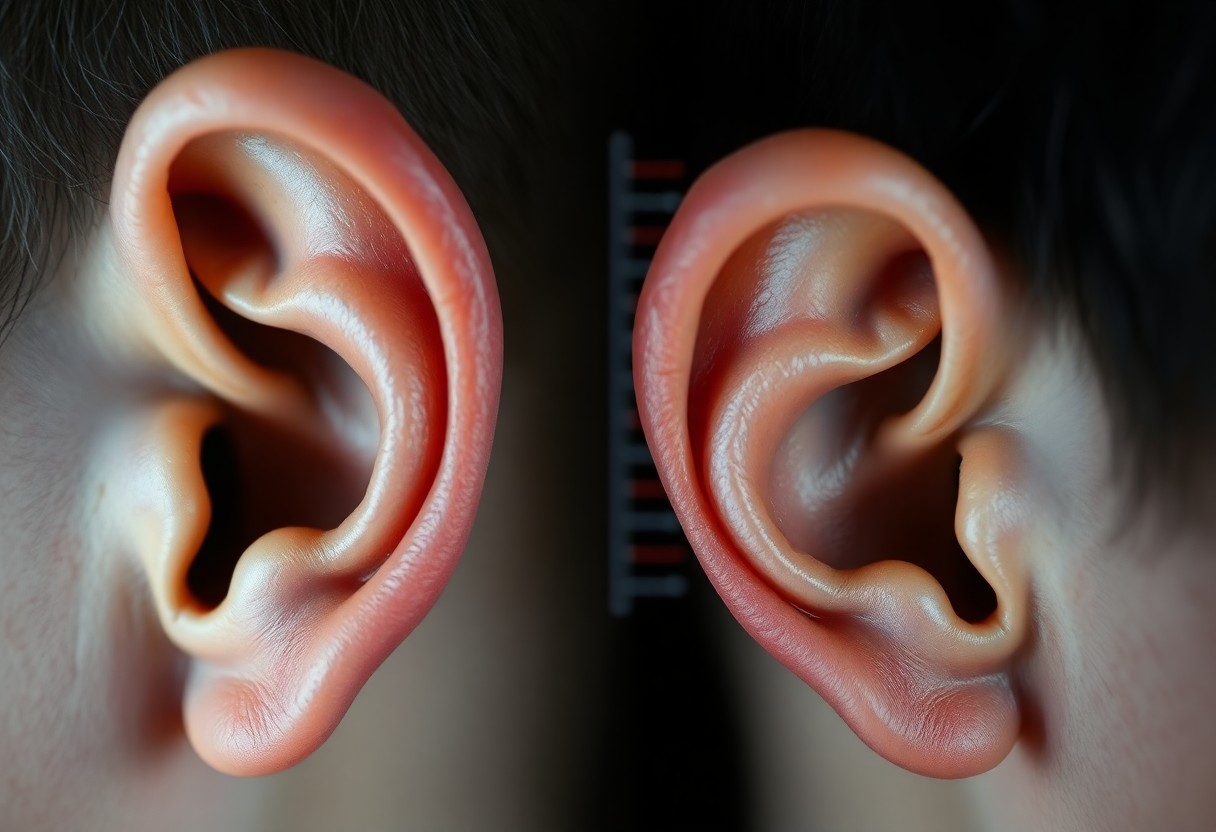
Evolutionary Advantages: Why Two Types Persist
- Adaptive traits for different environments
- Protection against varying pathogens
- Influence of climate on earwax type
- Role of genetics in earwax production
- Survival advantages in human evolution
| Type of Earwax | Environmental Adaptation |
| Dry Earwax | Cold climates for moisture retention |
| Wet Earwax | Humid environments for pathogen defense |
| Dry Earwax | Less humidity leads to lower bacteria growth |
| Wet Earwax | Helps prevent skin infections in warm areas |
The Adaptations of Dry Earwax in Cold Climates
In cold climates, dry earwax serves a vital role by minimizing moisture loss. The composition of dry earwax, which has a lower water content, helps to keep moisture trapped in the ear canal, preventing dryness and potential irritation. This adaptation is particularly beneficial in frigid environments where humidity levels are low, ensuring that your ears maintain moisture and remain healthy despite external conditions.
The Protective Benefits of Wet Earwax in Humid Environments
Wet earwax functions as an crucial barrier in humid climates, protecting your ears from bacterial and fungal infections. Its moisture-rich composition helps trap dust and debris while providing an environment that deters pathogens, making it advantageous for maintaining ear health where humidity thrives.
Wet earwax not only traps particles but also possesses antimicrobial properties. Its slick texture allows for easy movement of accumulated impurities out of the ear canal, minimizing the risk of infections that can occur in warm, damp conditions. This natural defense mechanism is critical, especially in regions prone to high humidity levels, where the likelihood of pathogen exposure is increased. Knowing these evolutionary advantages helps better appreciate the diversity in earwax types and their roles in human health.
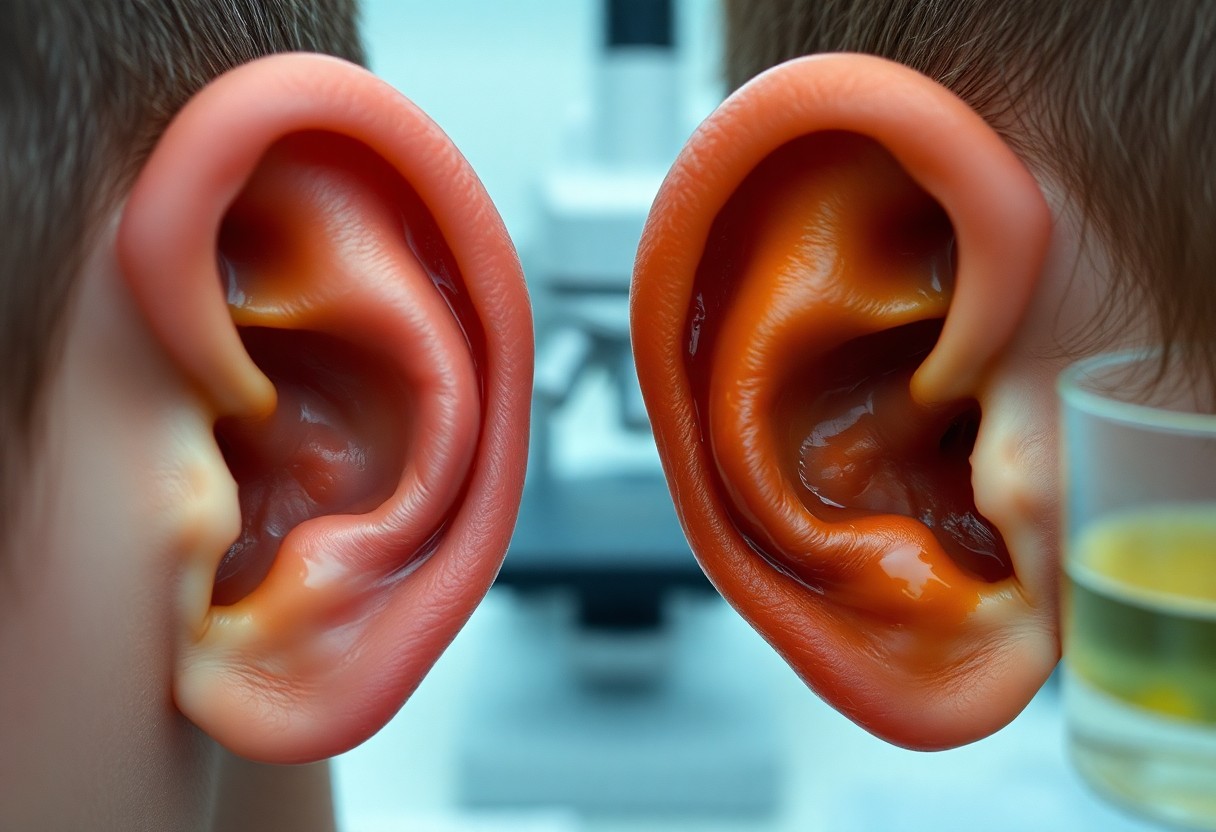
Beyond Genetics: Environmental Influences on Earwax
Climate Effects on Earwax Production
Your earwax type can also be influenced by the climate you live in. Humid environments often lead to increased earwax production, which serves as a natural barrier against moisture and temperature fluctuations. In contrast, dry climates may result in less earwax, as the body adapts to conserve moisture. This adaptation is particularly evident in populations residing in arid regions, where dry earwax is more common, highlighting the interplay between environment and bodily functions.
Dietary Contributions and Variations
Your diet significantly impacts the composition and amount of earwax your body produces. Certain foods, particularly those rich in fats and oils, may enhance earwax secretion, while others lacking vital nutrients can lead to drier wax. Cultures that consume high-fat diets, such as those that include avocados or nuts, often produce more moist earwax, showcasing a direct link between dietary choices and earwax characteristics.
The Societal Perception of Earwax Variations
Cultural Attitudes Towards Earwax Types
Cultural views on earwax can influence the way you perceive your own and others’ ear hygiene. Different societies have varying practices and beliefs surrounding earwax, ranging from disgust to indifference. For instance, some cultures may view wax accumulation as a sign of neglect, while others accept it as a natural part of anatomy.
- In some cultures, earwax is associated with cleanliness.
- Others might consider it a health indicator.
- Social media can amplify perceptions of ear hygiene.
- Regional practices vary significantly across the globe.
- Assume that these beliefs shape your personal grooming habits.
| Culture | Attitude towards Earwax |
|---|---|
| Western | Often seen as unclean |
| Asian | Can be viewed as natural |
| African | Cultural rituals may involve earwax |
| Middle Eastern | Varies by region, often linked to health |
| Indigenous | May hold traditional significance |
Misconceptions and Stereotypes
Your understanding of earwax may be clouded by stereotypes and misunderstandings. Many associate earwax types with cleanliness or personal hygiene, leading to unwarranted judgments about individuals. Such ideas can affect social dynamics, influencing how you perceive yourself and others based on wax type.
- The association of wet earwax with poor hygiene.
- Beliefs that dry earwax is a sign of genetic superiority.
- Generalizations about ethnicity based on earwax type.
- Media portrayal affects societal perceptions.
- Knowing these misconceptions can help you challenge stereotypes.
| Misconception | Reality |
|---|---|
| Wet earwax is unhygienic | It serves protective functions |
| Dry earwax equals health issues | It’s a genetic variation |
| Narrow definitions of cleanliness | Earwax varies across cultures |
| Judging someone by earwax type | It’s a genetic trait, not a personal choice |
| Assumed stereotypes from media | Reinforces bias against certain types |
The Evolutionary Significance of Earwax Types
| Earwax Type | Evolutionary Significance |
|---|---|
| Dry Earwax | More prevalent in colder climates; less water retention. |
| Wet Earwax | Common in warmer climates; better for trapping dirt and debris. |
| Genetic Variation | Different alleles influence earwax consistency. |
| Pathogen Defense | May help guard against specific environmental threats. |
| Population Adaptation | Reflects historical migrations and closeness to diverse pathogens. |
- Adaptive traits for varying environments.
- Protection against different pathogens.
- Facilitates hygiene in changing habitats.
- Aids in communication and mating practices.
- Thou shall appreciate the complexity of your own evolutionary narrative.
Protective Mechanisms Against Environmental Threats
Your earwax serves as a barrier, preventing dust, bacteria, and debris from entering your ear canal. This keeps your auditory system clean and reduces the risk of infections. The wax also has antimicrobial properties, designed to fend off pathogens that may invade your ears and potentially lead to health issues.
Adaptations to Climate and Humidity
Your earwax type can reflect environmental factors such as humidity and temperature. In arid regions, dryer earwax may help minimize moisture loss, while in humid climates, wetter earwax can effectively trap airborne contaminants. These adaptations enhance your resilience against local pathogens and environmental challenges.
The distinction between dry and wet earwax not only showcases genetic variation but also highlights your ancestors’ adaptations to their unique environments. In regions where moisture levels fluctuate, wet earwax acts as a natural defense by trapping larger particles and keeping the ear canal hydrated. Conversely, in drier climates, dry earwax may serve to prevent excess moisture, thus preserving ear health. Through these evolutionary adaptations, you can see how your personal earwax type has been shaped by both ancestry and environment.
Health Implications: Understanding Earwax Types
Different types of earwax can indicate varying health implications. Understanding these types helps in managing ear health effectively.
| Type of Earwax | Health Implications |
|---|---|
| Dry Earwax | Less likely to block the ear canal and may indicate lower bacterial activity. |
| Wet Earwax | More prone to buildup and blockage due to its sticky nature. |
| Associated with higher microbial populations possibly enhancing ear health. | |
| Can lead to discomfort or hearing loss if not managed properly. | |
| Thou should regularly check your ear health. |
The Impact of Earwax Type on Ear Health
Earwax type plays a significant role in your ear health. Dry earwax tends to be less messy and less likely to lead to blockages, whereas wet earwax can accumulate, potentially causing discomfort or hearing loss. Moreover, the composition can affect bacterial growth, influencing susceptibility to infections. An understanding of your earwax type can guide you in maintaining your ear hygiene effectively.
Common Conditions Associated with Each Type
Each earwax type has associated health conditions. Dry earwax, while generally benign, can sometimes lead to dryness in the ear canal, resulting in itchiness or irritation. Wet earwax can create a warm, moist environment, increasing the risk of infections such as otitis externa. If you frequently experience discomfort or blockage, recognizing the type of earwax you have is important for proper management and care.
For instance, conditions like impacted cerumen predominantly occur with wet earwax, leading to significant hearing loss in some cases. On the other hand, individuals with dry earwax might experience fewer ear-related issues but could still face challenges with itching or a sensation of fullness. Addressing these unique characteristics of earwax types can better inform your health decisions and improve overall ear well-being.
Health Implications of Earwax Type
Dry vs. Wet: What Your Earwax Says About Your Health
Your earwax type can hint at your overall health. Individuals with dry earwax often exhibit fewer issues related to ear infections, as this type is less conducive to bacterial growth. Conversely, wet earwax can sometimes indicate a higher risk of ear infections and buildup, leading to potential hearing problems. Each variant plays a unique role in protecting your ears, reflecting your genetic predisposition and potentially signaling underlying health conditions.
Common Misconceptions and Myths Debunked
Misinformation surrounds the topic of earwax types. One prevalent myth is that dry earwax is inherently unhealthy or undesirable. On the contrary, studies show that dry earwax has its protective benefits. Another misconception is that wet earwax leads to ear infections; while it does increase the likelihood of buildup, it doesn’t directly cause infection in healthy individuals.
Diving deeper, many believe a strong smell or excessive buildup of wet earwax indicates poor hygiene. In reality, these are normal variations and often occur in response to the body’s needs. Genetics significantly influence earwax types, meaning some people are predisposed to produce more. Understanding these nuances helps discard myths and promotes a clearer perspective on earwax’s role in ear health.
Genomic Testing: What You Can Learn About Your Ears
How DNA Testing Reveals Earwax Type
DNA testing can provide direct insights into your earwax type by analyzing specific genes associated with cerumen production. The ABCC11 gene is critical here; variations in this gene determine whether you produce dry or wet earwax. By simply providing a saliva sample, you can uncover the genetic factors influencing your earwax type, revealing a unique aspect of your genetic makeup.
Interpreting Your Genetic Results
Understanding your genetic results can clarify not just your earwax type but also potential health implications. Genomic reports will typically highlight whether your ABCC11 gene is linked to dry or wet earwax, offering a straightforward interpretation of your genetic profile. This information can also lead to discussions about hereditary traits and overall health.
Interpreting your genetic results opens up avenues for understanding how earwax type can relate to other health conditions. For example, wet earwax is often associated with higher body odor levels due to genetics linked to apocrine glands. In contrast, dry earwax might be correlated with a lower risk of certain skin conditions. Such genetic insights can encourage more personalized health approaches and foster awareness regarding hereditary preferences, enhancing your understanding of personal wellness and family traits.
Personalizing Ear Care: Implications of Earwax Type
Tailored Approaches for Dry and Wet Earwax
Your earwax type can guide personalized care strategies. For those with dry earwax, which is less sticky, frequent cleaning may be necessary to prevent buildup. Conversely, wet earwax may require less frequent removal but benefits from gentle methods to ensure hygiene without causing irritation. Understanding these differences allows you to adopt strategies that suit your unique ear type.
Recommendations for Ear Maintenance and Hygiene
Effective ear maintenance depends on your earwax type. For individuals with dry earwax, consider using lubricant drops to soften the wax and facilitate easier removal. Those with wet earwax should focus on regular cleaning intervals, using cotton swabs with caution to avoid compaction. Incorporating ear cleaning into your routine helps maintain ear health while considering the characteristics of your earwax.
Daily ear hygiene can significantly impact your ear health. You can use a soft cloth to wipe the outer ear, ensuring you avoid inserting objects deep into the canal. For dry earwax, a few drops of mineral oil weekly can keep the earwax manageable. Moistening the ear canal assists in naturally expelling wax without aggressive interventions. For wet earwax, using a gentle ear cleaning solution once a month may prevent excess buildup. These tailored approaches not only promote cleanliness but also protect sensitive ear structures from harm or infection.
Practical Tips for Earwax Management
- Regularly clean your ears using a damp cloth; avoid inserting objects into the ear canal.
- Use over-the-counter earwax removal drops if necessary.
- Avoid using cotton swabs, which can push wax deeper into the ear.
- Stay hydrated to help maintain normal earwax consistency.
- If you have dry earwax, consider applying a few drops of mineral oil occasionally.
This approach will help maintain your ear health and manage earwax effectively.
Best Practices for Ear Hygiene Based on Earwax Type
Managing ear hygiene effectively depends on your earwax type. If you have wet earwax, periodic cleaning may be sufficient, as this type tends to naturally migrate out of the ear. For dry earwax, you might need to be more proactive, using gentle methods to avoid buildup. Always prioritize gentle cleaning techniques to avoid irritation.
When to Seek Professional Help
Professional evaluation becomes necessary if you experience symptoms like hearing loss, itching, or pain in your ears. Persistent blockage or excessive earwax buildup often requires a healthcare professional for safe removal. You might also consider seeking help if home remedies don’t provide relief or if your earwax appears abnormal in color or consistency.
For those dealing with more severe cases, medical professionals can perform procedures such as irrigation or suction to clear excessive wax without harming the ear drum or canal. If you’re facing discomfort or recurrent blockages, regular check-ups may be recommended to create an effective management plan tailored to your earwax type.
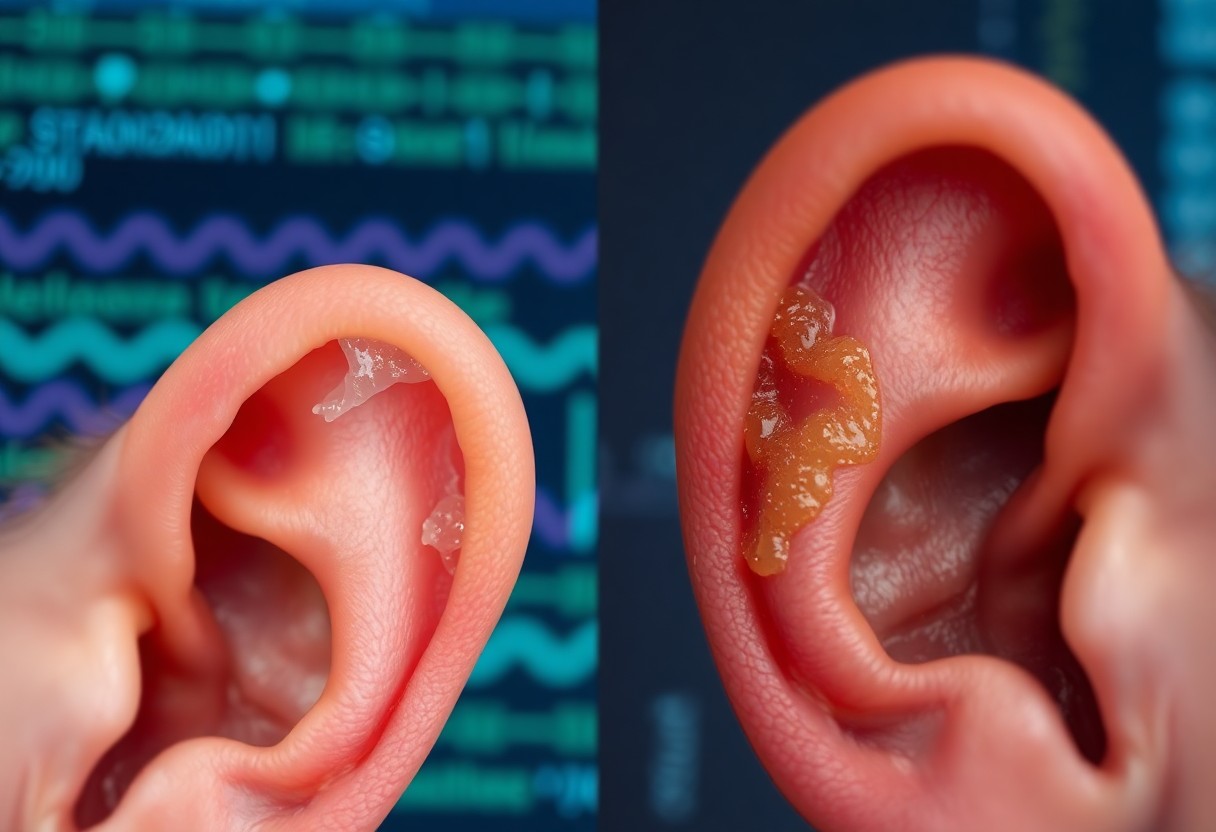
The Future of Earwax Research
Emerging Studies and Breakthroughs
Recent studies are exploring the complex genetic factors influencing earwax type, with researchers discovering variants in the ABCC11 gene linked to the wet or dry classification. Innovations in genetic analysis technology are allowing scientists to conduct larger-scale studies, leading to potentially groundbreaking insights about earwax and its implications for personal health. These studies aim to unravel the connections between earwax types, hygiene practices, and susceptibility to certain health conditions.
Genetic Testing and Its Implications for Earwax Understanding
Genetic testing is paving the way for deeper insights into why your earwax type is what it is, shedding light on inherited traits. With advancements in genomic testing, you may soon understand not only your earwax type but also your predisposition to specific health issues related to it. This could help in developing personalized hygiene routines or health screenings based on genetic profiles.
The implications of genetic testing extend beyond mere classification of earwax types. By analyzing your genetic information, researchers can identify correlations between earwax composition and conditions such as asthma or obesity. Understanding these connections can lead to novel therapeutic approaches aimed at improving overall health based on your unique genetic makeup. Additionally, awareness of genetic predispositions allows you to take proactive measures, making informed decisions that could positively affect your well-being.
Final Words
As a reminder, understanding the genetics behind dry and wet earwax can provide insights into your own ear health. Your earwax type is determined by specific genetic markers, influencing not only its appearance but also its function in protecting your ears. By knowing the characteristics associated with your earwax type, you can better appreciate how your body works and make informed decisions regarding your ear care. This knowledge empowers you to take a proactive approach in maintaining your ear health moving forward.
Conclusion
As a reminder, understanding the genetic factors behind dry and wet earwax types offers insight into your own ear health. Your earwax composition is determined by inherited traits, reflecting broader genetic variations within populations. By recognizing whether you belong to the dry or wet earwax group, you can appreciate how genetics shape not just your ears but your overall health. Staying informed about these differences can enhance your awareness of potential ear-related issues and guide appropriate self-care practices.
FAQ
Q: What is the main difference between dry and wet earwax?
A: The main difference lies in their composition and texture. Wet earwax is sticky and yellowish, while dry earwax is crumbly and light in color. This variation is largely due to genetics.
Q: How does genetics influence earwax type?
A: Genetics plays a significant role in determining whether an individual will produce dry or wet earwax. The gene responsible for this is the ABCC11 gene, where certain variants lead to dry earwax production, while others result in wet earwax.
Q: Are there any health implications associated with dry or wet earwax?
A: Generally, both types of earwax serve the same purpose in protecting the ear canal. However, some studies suggest that dry earwax might be associated with lower risks of certain ear infections compared to wet earwax.
Q: Can the type of earwax change over time?
A: The type of earwax is typically stable throughout an individual’s life, as it is based on genetics. However, factors such as age and health conditions might influence earwax production and appearance.
Q: Is there any significance in the geographic distribution of earwax types?
A: Yes, studies indicate that the frequency of dry versus wet earwax varies across different populations. Dry earwax is more prevalent in East Asian populations, while wet earwax is common in African and European populations, highlighting the genetic diversity linked to this trait.

